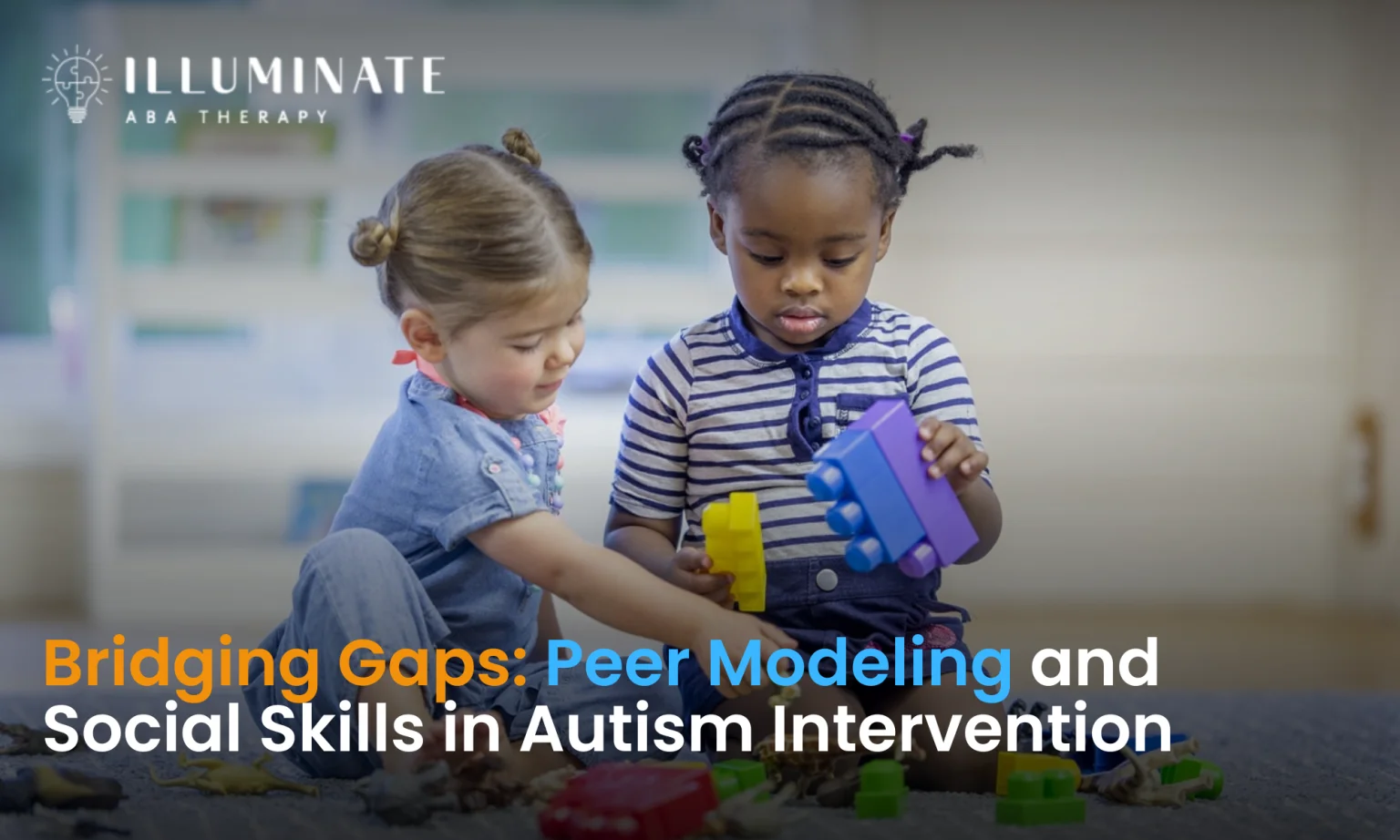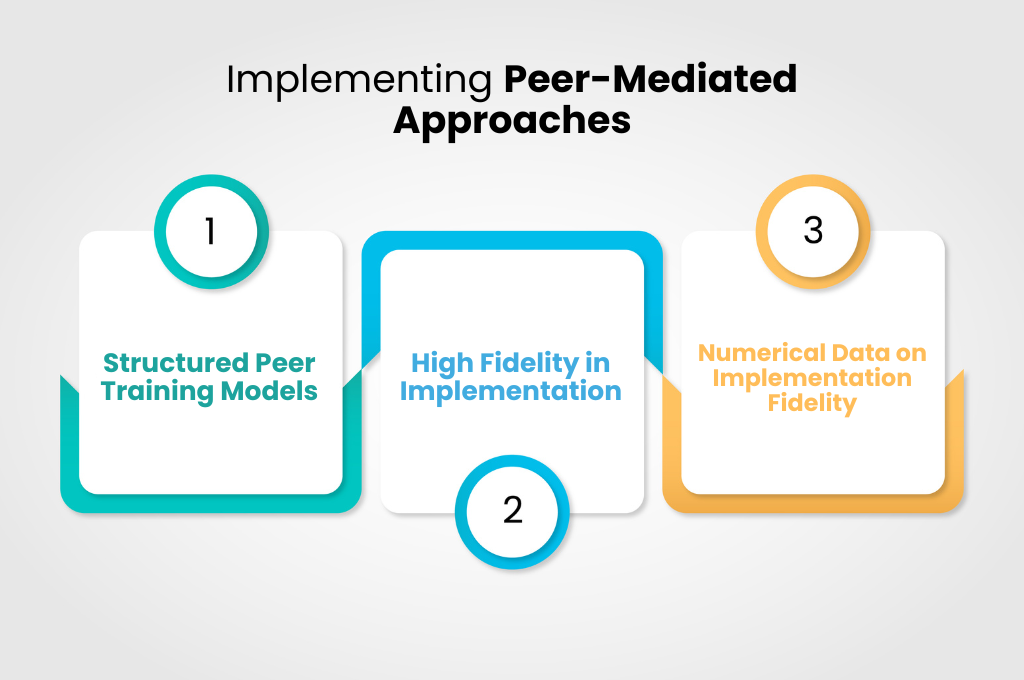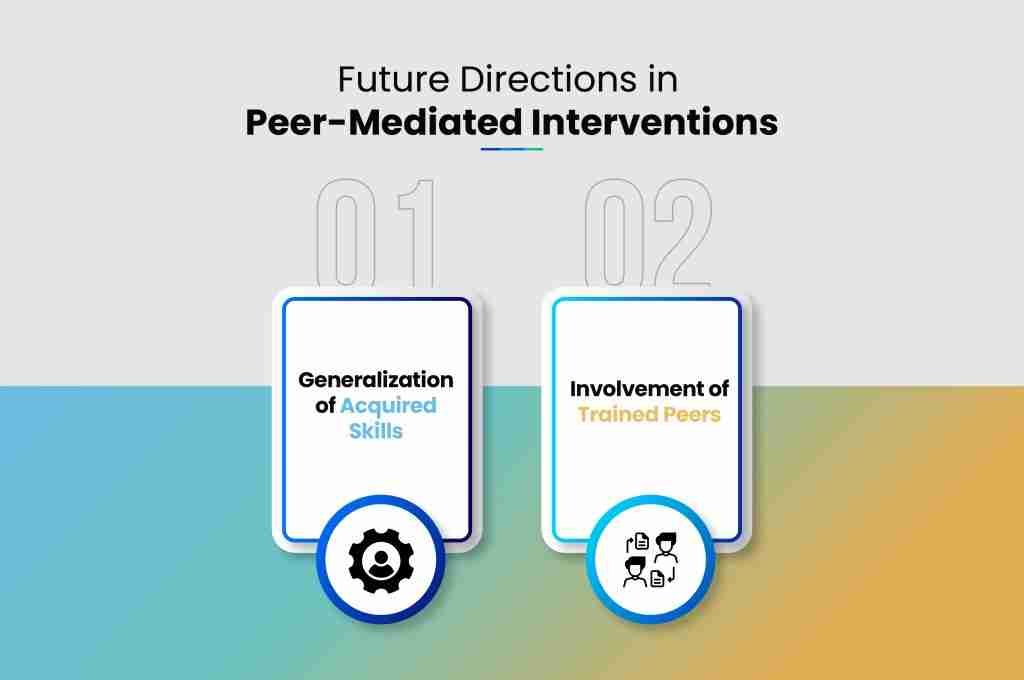Bridging Gaps: Peer Modeling and Social Skills in Autism Intervention
ABA TherapyJuly 17, 2025

Peer Modeling in Social Skills Training
Peer modeling is getting a spotlight for its impact on boosting social smarts among kids with autism. Studies show this technique—where friends become role models—can really help children on the Autism Spectrum shake hands with better social skills.
Benefits of Peer-Mediated Intervention
Enter peer-mediated intervention (PMI), a method that’s quickly becoming a go-to for building social skills in kids with autism. Through this style, classmates who naturally flow through social stuff become teachers for those who struggle a bit.
These peer models often make more friends with kids with ASD—they’d pick these kids for kickball any day. And those friendships? They grow stronger with time, bringing smiles to everyone involved.
Sprinkling in classmates who are on the ball socially, especially when kids are between 3 to 8 years old, is like adding extra spice to the learning pot. Peer-led playtime isn’t just fun; it’s a way for kids to learn to share, help out, and cheer each other on. This not only builds social vocabulary but also creates a comfy space for all kinds of learning.
Improving Social Initiations and Responses
Lots of kids with autism want to say "hello" but might not have the playbook on how to do it right. This can lead to ducking out of social gatherings or acting up until they figure things out.
Studies suggest PMI lifts the curtain on how to kickstart a chat and keep it going. Kids learn not only how to interact but also when to nod, smile, or wave back. For those with mild to moderate ASD, PMI packs more punch than the usual behavioral lessons based on Applied Behavior Analysis (ABA).
Intervention Type
Improvement in Social Skills
Peer-Mediated Intervention
Big jump in skills
Traditional Behavioral Therapy (ABA)
Some improvement
Adding PMI to the mix can really arm kids with what they need for more fulfilling interactions. Family, mentors, and teachers can use this power along with tools like understanding functional behavior assessments (FBAs) and advice on smooth transitions with ABA for children with autism to make instruction stronger and more complete.
For those crafting cozy spaces conducive to ABA therapy, check out our piece on creating a sensory-friendly environment.
Implementing Peer-Mediated Approaches

If you're working with kids on the autism spectrum, you'll want to know about peer-mediated interventions (PMIs). Basically, it's like putting kids in a group where they can learn from each other. These setups use peer role models to teach social skills, which can really help kids with ASD connect better in everyday situations.
Structured Peer Training Models
The way these interventions roll out usually involves picking some stand-up students to lead by example. These peers are often the social butterflies of the class, the ones teachers think have the chops to be positive role models. Through this setup, peers learn how to connect with kids with ASD, nudging along skills like making eye contact, sharing toys, and having those back-and-forth chit-chats.
Here's how it generally breaks down:
- Selection of Peers: Teachers tap into their wisdom to pick peers who shine socially and can rub off those skills on others.
- Training Sessions: These chosen ones then sit through some quick lessons on how to play the social game with ASD kids.
- Implementation: Time to put theory into practice! Trained peers hang out with their ASD classmates, trying out what they've learned in real-life settings.
- Monitoring and Feedback: We keep an eye on how it's going and offer some pointers, so everyone's game can reach the next level.
High Fidelity in Implementation
Executing PMIs isn't just about putting them in motion, but it's about doing it right. Studies back up the idea that sticking to the plan boosts how effective these interventions are. Basically, implementation fidelity means keeping things tight and on-script. For PMIs, that success range is a cozy 86% to 94%.
What keeps the train on the tracks? Here's the scoop:
- Training Quality: Making sure peers get top-notch guidance.
- Ongoing Support: Keeping mentors in the loop, offering help whenever needed.
- Consistency: Sticking to the game plan once it's set.
Numerical Data on Implementation Fidelity
Study
Fidelity Percentage
Study A
86%
Study B
89%
Study C
94%
While sticking to the script is crucial, making sure these new skills stick across different settings needs some more attention. For the lowdown on what generalization in ABA is all about, you’ll find plenty of resources. This is key to ensuring the skills learned during these interventions make it past just the classroom.
Want to dig deeper into making ABA strategies work? Check out our tips on building effective social stories for autistic kids and playing our way into ABA therapy. These insights are handy in getting the most fun and effectiveness out of ABA sessions.
Peer Models in Social Skills Interventions
In helping kids with autism spectrum disorder to sharpen their social skills, having other kids set examples can be game-changing. These peer models help open up doors, showing improvements in things like getting included in the friend circle and picking up on those all-important non-verbal cues.
Social Network Inclusion
When kids help other kids, it often results in the buddy system boosting the social connections for autistic children. The ones who act as peer models often sit right in the middle of the social map, like the hub of a wheel. They're the ones that hold many connections and play a crucial part in how social circles shape up.
To break it down, kids acting as peer models tend to get more invites to hang out and have better quality friendships than those not involved. They also feel less lonely overall. Take a look at the table below for the summary:
Peer Model Type
Inside Network
Friend Invites
Friendship Quality
Loneliness
Peer Models
High
High
High
Low
Non-Peer Models
Low
Low
Low
High
By bringing autistic children into the circle, peer models create a more welcoming vibe, helping kids on the spectrum grow socially.
Non-Verbal Social Skills Development
Non-verbal skills, like knowing when to look someone in the eye or take turns, are key when chatting with kiddos on the spectrum. These programs where kids help kids have been rocking it at boosting these skills.
Peer models can make a real difference by:
- Eye Contact: Getting kids to look up and connect with their eyes.
- Shared Focus: Helping them point and look at the same thing, which is super important in learning how to connect socially.
- Taking Turns: Making playtime more fun and interactive, ensuring everyone gets a chance.
And here's the kicker: it's not just about sticking to the playbook during class or therapy; this stuff carries over to all sorts of places. When peer models and autistic kids hang out regularly, autistic kids get to practice and fine-tune these skills all over the place.
Teachers and caregivers who want to try this should gear up the peer models through proper training and continuous support to really see the magic happen. Check out our guide on creating effective social stories for children with autism for more helpful hints.
Basing these ideas on what's worked in the past, peer models point to long-lasting positive changes, becoming a vital part of shaping these social skills programs. For more tips and tricks on facing autism's unique challenges, hop over to our resources on addressing co-occurring conditions in ABA therapy and the use of play in ABA therapy.
Peer Models vs. Non-Peer Models

Social Network Centrality Comparison
When you're checking out how peer models influence social skills training in kids with autism, you gotta look at their social network status. Basically, social network centrality boils down to how many folks you know and hobnob with within a group. According to, kids who act as peer models usually have a bigger circle of friends in class from start to end compared to those who aren't peer models. Here's a quick peek at the data:
Group
Baseline Centrality
Exit Centrality
Friendship Nominations (Baseline)
Friendship Nominations (Exit)
Peer Models
High
High
More
More
Non-Peer Models
Lower
Lower
Fewer
Fewer
Peer models attract more friendship nods (or indegrees) than their non-peer counterparts at both the start and end of studies. This means they're not just mingling well but are also key in building social bridges, which is a good thing for kids with autism trying to blend in.
Friendship Quality and Loneliness Levels
Another biggie is checking how tight those friendships are and whether loneliness is creeping in. Good friendships are all about support, good vibes, and fun times, whereas loneliness is like being at a party but feeling left out. The data shows peer models felt less lonely at the start compared to non-peers, though later on, everyone was on the same page. This implies peer models keep their friendships solid, which helps them shine in these social skill programs.
Group
Baseline Loneliness
Exit Loneliness
Friendship Quality (Baseline)
Friendship Quality (Exit)
Peer Models
Lower
No significant difference
High
High
Non-Peer Models
Higher
No significant difference
Moderate
Moderate
Peer models were more likely to befriend kids with autism from the start and as time went on. These bonds don't just boost social acceptability for autistic kids; they also give them more chances to perfect their social game.
If you’re curious about similar topics, our article on how play is used in ABA therapy to hook kids in might tickle your fancy.
Grasping these social nuances is super important for parents, caregivers, and teachers aiming to nail ABA therapy strategies that help children with autism mingle and improve their skills. While both peer and non-peer models have their perks, peer models bring a big bonus by boosting social bonds and cutting down on feeling lonely.
Impact of Peer Models
Stability and Positive Social Behavior
When it comes to social skills interventions, peer models have repeatedly shown they're the go-getters of the group. They hold a far stronger social presence, make better friends, and don't feel as lonely compared to those not in their shoes. Peer models seem like magnets, drawing friendship nominations from classmates like bees to honey.
Parameter
Peer Models
Non-Peer Models
Social Network Centrality
Up there
Needs a boost
Friendship Nominations (Indegrees)
Plenty
Just a sprinkle
Friendship Quality
Top-tier
Needs work
Loneliness Levels at Baseline
Less lonely
In their own bubble
Loneliness Levels at Exit
No big change
No big change
Standing tall in the social network, peer models are often the key players in the social scene, especially for kiddos on the autism spectrum. Their solid spot in the network helps keep things on an even keel in the class—making a more harmonious space. Want to amp things up a notch? Check out strategies like behavioral contracts: tools for success in ABA.
Connection With Children With ASD
Peer models don't just stop at the periphery; they click well with children with autism, like pieces of a carefully crafted puzzle. From the get-go till the end, they choose kids with autism to be their buddies, ensuring everyone gets a smiling face in the friendship circle.
Connection Metric
Peer Models
Non-Peer Models
Picking Children with ASD as Friends (at the Start)
Frequent
Rare
Picking Children with ASD as Friends (Later)
Frequent
Rare
This positive bond does wonders, fighting off that sense of isolation that kids with autism might feel, turning it instead into a chatty, friendly environment. To keep this warm glow going, activities like creating effective social stories for children with autism are super helpful.
Plus, with peer models in the mix, the classroom scene often improves overall. Everyone gets a chance to sharpen their social skills, turning the place into a buzzing hub of communication. Curious about boosting social skills in more playful ways? Dive into our piece on the use of play in ABA therapy: engaging children effectively.
Future Directions in Peer-Mediated Interventions

Generalization of Acquired Skills
One big stumbling block with peer-mediated interventions is helping kids take the skills they've learned and use them with different people and in new situations. Researchers say these interventions work well at boosting social and talking skills for children with autism, but getting those skills to stick in new settings is another story. Sometimes, kids learn how to chat and respond correctly in structured places but then hit a wall when they try it elsewhere.
Here's how you can help make those skills stick:
- Change of Scene Exposure: This means practicing new skills in as many places as possible—like the park, school, or around the neighborhood.
- Mix Up the Peer Group: Letting kids interact with a mix of friends can help make sure they're not just comfortable with one person or place.
- Skill Reinforcement: Stick with what works and repeat it everywhere. Kind of like always giving a thumbs up when they get it right. Parents and educators might want to have a peek at strategies in behavioral contracts for more tips.
A quick look at how different places can impact skill retention:
Environment
Skill Retention (Yes/No)
Classroom
Yes
Playground
No
Community Center
Yes
This shows how mixing settings matters.
For more insights, swing by our piece on generalization in ABA right here.
Involvement of Trained Peers
Bringing in typically developing kids as "models" is proving to be really helpful for children with autism. However, there's still loads of discussion around how much these interactions help the kids use their skills in new situations.
Here’s how bringing in trained peers can help:
- Building Social Circles: Getting kids to play with peers who are models can widen their social circle, help them make quality friends, and feel less alone.
- Keeping It Consistent: Regular meet-ups with trained peers can keep new social skills fresh and solid.
Here’s some data on the difference peer involvement makes:
Social Outcome
Pre-Intervention
Post-Intervention
Social Network Centrality
Low
High
Friendship Quality
Poor
Improved
Loneliness Levels
High
Reduced
These results are taken from.
For a deep dive into making these strategies work, check our page on the importance of family involvement in ABA therapy.
With more focus on these next steps, caregivers and teachers can give kids with autism the tools they need to really improve their social skills for the long haul. For even more ways to help, consider taking a look at other intervention methods like crisis intervention strategies in ABA.
Get More Insights: Crisis Intervention in ABA Therapy for Autism Support
